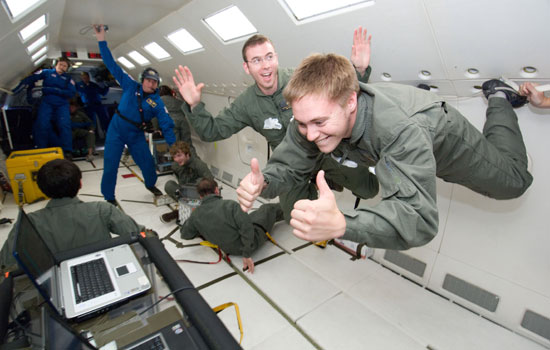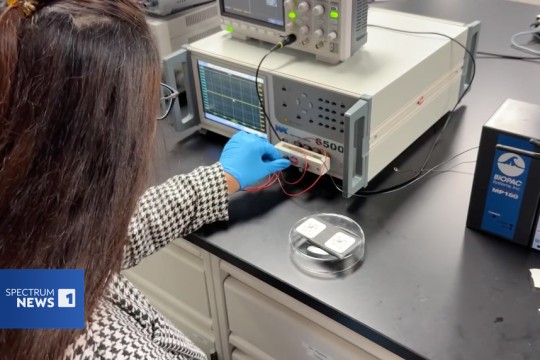Student team takes flight on NASA’s ‘Weightless Wonder’ aircraft
Submitted by Robert Markowitz/NASA
Greg Sharp gives a thumbs up alongside Jarret Whetstone as they experience zero gravity aboard NASA's Weightless Wonder aircraft
Three recent graduates and one student from RIT’s imaging and photographic technology program experienced human spaceflight without leaving earth’s orbit. The team of James Craven, Greg Sharp, Christopher Ubelacker and Jarret Whetstone earned an opportunity to fly aboard NASA’s Weightless Wonder, a C-9 aircraft that climbs to a 45-degree angle over the Gulf of Mexico and then nosedives to simulate zero gravity.
RIT’s team spent a week in July at NASA’s Johnson Space Center in Texas along with teams from University of Texas at Austin, Texas A&M, University of Michigan and University of New Mexico as part of NASA’s Reduced Gravity Student Flight Opportunities Program. The program allows undergraduate students to propose, build and fly a reduced gravity scientific experiment. RIT was one of 40 selected from more than 80 submissions.
“I am really excited I got to go,” says Sharp ’08. “It was a lot of fun. You did end up floating off the floor. I found I had to keep grabbing on to things to keep myself from floating all over uncontrollably.”
The aircraft, more popularly known as the “Vomit Comet” follows a parabolic flight path, providing short periods of free fall in which people experience reduced gravity or weightlessness, similar to a ride on a rollercoaster. During the 90-minute flight, participants experience more than 30 free falls, each lasting between 18 and 25 seconds.
The team’s experiment looked at the feasibility of inkjet printing in a microgravity environment, focusing on print heads, ink drop characteristics, ink drop flight and printing accuracy.
“We tested thermal and piezo electric methods of inkjet printing in microgravity, consisting of two different tests, printing out standard targets to see if there were any changes in print quality,” says Craven ’08. “We also used a high-speed camera to image an inkjet droplet to see if there was a difference in size, shape, speed and amount.”
The data is being examined and the team will submit its research findings to NASA.
“The creation of circuit boards could be one potential application used in space by utilizing modified inkjet technology,” says Ubelacker, a fourth-year student. “The technology requires placing small volumes of liquid into a very accurate location so our data from the printers could be helpful.”
The team met many RIT alumni who work at Johnson Space Center and had the chance to present their experiment to astronaut Barbara Morgan. They also toured mission control for the International Space Station.
This is the second time NASA has selected a student team from RIT to be part of this program. In 1997, four undergraduate students in the imaging and photographic technology program flew aboard the Vomit Comet.
So did the Vomit Comet live up to its reputation? For some, but not all.
“Weightlessness is quite an interesting experience along with the nausea that comes with it,” says Whetstone ’08. “Luckily for me, I did not expel anything.”













